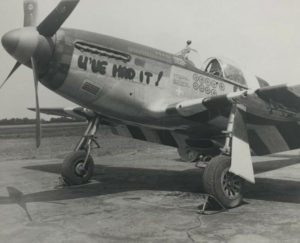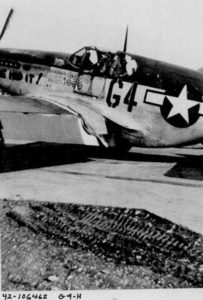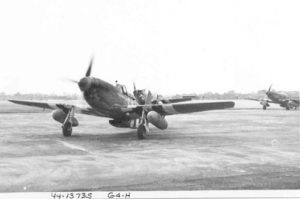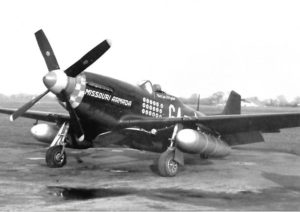
Notes on the four P-51s flown by Major John Brooks England, Feb 1944 – Jan 1945, 362nd Fighter Squadron, 357th Fighter Group
By Merle Olmsted, Historian, 357th Fighter Group, July 2003
During April, 1964, the widow of John B. England, Mrs. William Huff, loaned this writer John’s wartime photo album and assorted papers. Under a photo of MISSOURI ARMADA, he had attached a note which says, “This P-51 was the fourth and last plane I used during my tour in England. This plane completed over 30 missions over the German Reich without an abort. The man chiefly responsible for this planes consistent record was S/Sgt Robert Currie. He was a wonderful Crew Chief and a credit to our great unheralded Army Air Forces ground crews.”
Two of these P-51s are well known, the first a P-51B, serial number 42-106462, named U’ve Had It. It was 362nd code G4-H.
The other well known P-51 was a D Model, s/n 44-14789, code G4-E. He flew this one on his last 30 missions, and it was the last of the four. His final mission was 15 January 1945.
The third of his known P-51s was a D-5, s/n 44-13735, code G4-H. Available photos of it do not reveal any name on the left side – there are no photos of the right side. Victory symbols range from nine to twelve.
We will discuss these three P-51s in detail, and deal with the “mysterious” 4th P-51 later.

P-51B-10, s/n 42-10642, U’ve Had It, was delivered to the AAF at the California factory on 20 January 1944. It departed the U.S. from Newark, NJ, by sea on 8 February, 1944, arrived in England and was assigned to 8th Air Force 21 February, 1944. It usually took from one to two weeks for the depot to process the aircraft that came in, so it probably was delivered to Leiston, and the 357th Fighter Group about the end of the first week of March.
The 357th flew it’s first operational mission 11 February. England flew this first mission and four more through 8 March. Since what was to be U’ve Had It did not arrive until early March, what aircraft did John England fly for his first month or so? We will deal with this question later.
To complete our story on 42-106462. England was in Scotland on a gunnery course from 25 April until 14 May, and flew no missions. The only known photos of this aircraft show it with the “half” paint job, widely used by the 357th in the spring of ’44. (Bare metal fuselage sides and olive drab upper surfaces. It would arrive at Leiston in the full OD and gray scheme.) Two photos from the England album show it with the original canopy and four victory symbols. One photo shows it with seven symbols. He scored his 4th victory on 13 April. Two other photos, one taken by this author, show it with nine victory symbols, a Malcolm hood and full invasion stripes. He scored his 9th victory on 18 August, by which time he was no longer flying this aircraft, so the 9th symbol cannot be explained.
In a letter dated 29 May 1944, he says his aircraft was hit by machine gun fire in the aft fuselage. In a letter dated 2 June, he says he is thankful for armor glass and self-sealing tanks. Both comments may relate to the mission of 21 May, when nine aircraft were damaged during strafing attacks on an airfield. During the time 462 was under repair he would have flown whatever was available.
We don’t know how much longer he flew U’ve Had It, but probably through June. By the first part of July, his new D model was on the scene.
To complete the story of 462: It was flown on the August shuttle mission to Russia by Flight Lieutenant Eric Wooley, RAF, by which time it was G4-Y. It finally met its final fate on 4 October, when the tail section separated during a high-speed training dive. 2nd Lt. Richard “Rip” Potter, with great difficulty, bailed out successfully.
By the time of the shuttle mission to Russia (6 through 12 August, 1944), John England was flying his new P-51D, 44-13735. Photos taken at the time of the shuttle mission departure, show it with nine victory symbols, all in one line under the canopy edge. There is no name on the left side, and there are no photos of it from the right. 735 had departed Newark by sea in June, 1944, and received at Leiston somewhere around 1 July (the record card on this aircraft is garbled.)
At this point there are some puzzling entries in his letters. On 1 October, he says he bellied in 44-13738 (this was G4-X, JOKER). In an undated letter, he says an 88mm shell exploded under the fuselage, so that he had to belly it in. It is not known if this relates to the comment on 738. On 5 October he says he wrecked his aircraft and would soon be getting another. No evidence has been found to show his relationship with 738. 44-13738 was wrecked on 1 October, but the AAF accident report shows the pilot to have been Lt. Harold Wyatt, the aircraft was a total loss.

However, John England’s un-named 44-13735 was damaged in a landing accident on 1 October, with pilot Lt. Sam Fuller. It was due to landing gear malfunction, with damage limited to right gear, prop and wing tip. At this time it had 12 victory symbols arranged in two lines.
The list of aircraft accidents at Leiston airfield do not show any involving John England., Possibly the list is not complete.
On 2 November, his un-named (as far as we know) 44-13735 was lost with Major Lawrence Giarrisso, when a wing separated during combat. At this time, however, it was G4-N, which it probably became after repairs from the 1 October accident.
In mid September, 1944, 4414789 was ferried to Leiston and was assigned to John England. Unlike his other P-51s, which had been coded G4H, this one was G4-E. He flew it for the remainder of his long extended combat tour, which ended in January, 1945. It now had 18 of the distinctive 362nd Squadron victory symbols, for his total of 17.5 victories, only one off that of top group scorer, Kit Carson. John England survived his long combat tour, but was killed in an F-86 accident in 1954, in France.
After Major John England completed his extended combat tour in January of 1945, 44-14789 was assigned to pilot Lt. Tom Ridley, who re-named it Sad Sack, a poplar military cartoon character of the time. He flew it until 18 April, when he was shot down, the last 357th combat loss of the war. Ridley bailed out successful, and with the war over, soon re-joined the squadron.
This brings us to our mysterious fourth P-51, about which nothing is known, but I have developed a theory, which might identify it.
A basic tool I have used for years to identify 362nd Squadron aircraft, is a photo taken in the squadron operations office. It is primarily a photo of two men, SSgt Enerst Fleisch, squadron parachute rigger, and SSgt Jack Paschal, Operations NCO. On the wall behind them is a chart showing all the squadron aircraft, with their code letter, and the last three digits of their tail number. The date of the photo is unknown, but the earliest loss of aircraft on the chart is G4-I, 43-7176, MIA on 29 April, 1944. The photo then, has to be previous to that date – a fairly early photo.

On the chart, G4-H is shown as 462, the last three digits of U’ve Had It, 43-106462. Amazingly enough, however this may not be correct. It may be another P-51 with the same last three numbers, this being 43-12462. We know this P-51 was in the 362nd Squadron, because the logbook of Lt. Don Vogel shows he flew this airplane and many others on the chart. Don Vogel was shot down on 1 July, 1944, but evaded capture. Oddly enough he was flying a P-51 43-12455, only seven digits off from the one in question.
Research into 43-12462 shows that it was a P-51B-1 and it arrived in England and was assigned to the 8th Air Force in September, 1943. Many of these early P-51Bs were used to equip the 354th Fighter Group, the Pioneer Mustang Group, in November, 1943.
We know that the 354th passed on some of it’s older aircraft to the 357th when it became operational several months later. It is a safe bet that 43-12462 came to the 357th as one of these “hand-me-downs”, and was indeed, John England’s first P-51. There are no photos of it, and whether it had a name or not is unknown. From the wall chart though, we do know it was G4-H, England’s code letter.
Since this was already an “old” aircraft, the 357th probably passed it along to another new group sometime in the spring. John England then got his well known P-51B-10, U’ve Had It. 43-12462 survived it’s further adventures, whatever they were, and according to the aircraft record card, it was condemned as “excess” in October, 1944.
Now all we need is photographic proof, which it is unlikely we will ever get.
Merle Olmsted July 2003



